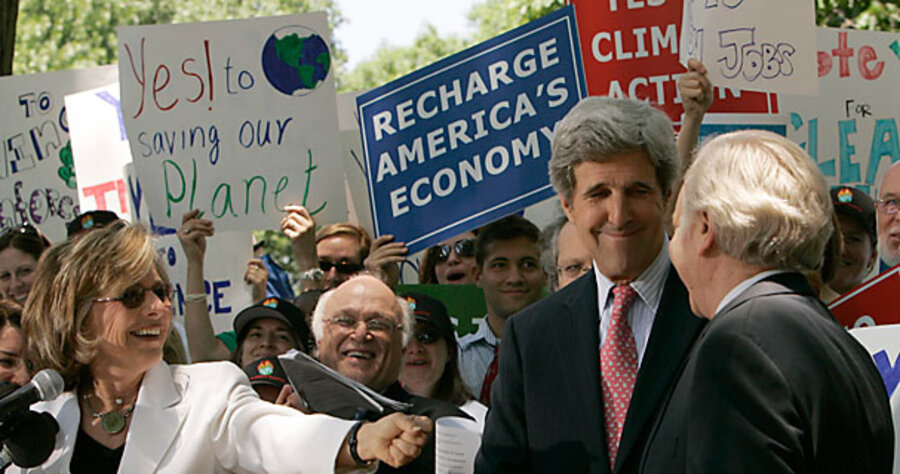Carbon cuts: how costly?
Loading...
| Washington
Reducing US greenhouse-gas emissions would cost the economy money. As the Senate debates a bill this week to do just that, one key question is: How much will it cost?
Predictions of the price of future cuts in carbon dioxide and other greenhouse-gas emissions vary as widely as predictions of future climate change itself. They range from a negligible reduction in economic growth to the loss in 20 years of millions of US jobs and $6,000 in annual income for every household in the country.
Much of the variation in cost assumptions may be due to different predictions about the speed with which new, greener industries and technologies will arise and the extent to which US consumers will embrace their products.
Many supporters of legislative action also argue that the worst-case cost scenarios ignore the price of inaction. Global warming could result in expensive increases in hurricane damage and other climate-related costs, they say.
“Climate change is on a collision course with the US economy, long before the end of the century, unless we act now,” said Frank Ackerman, a Tufts University economist and coauthor of a recent study on the economic effects of global warming, on May 22.
That’s not the way the White House sees things. On June 2, President Bush called the bill now under Senate consideration “a huge spending bill fueled by tax increases” and said it would impose roughly $6 trillion in new costs on the US economy.
The bill would add 53 cents to the price of a gallon of gas by 2030, according to a new administration analysis. The cuts in carbon emissions called for under the legislation “have no chance of being realized and have every chance of hurting our economy,” said the analysis.
The 500-page climate change bill the Senate is debating this week is unlikely to pass the chamber. If it did, it would surely face a White House veto.
But it could be a harbinger of action in the next administration. All three major presidential candidates support its basic structure of capping emissions of America’s major greenhouse gases, then establishing a trading mechanism to facilitate the buying and selling of permits to emit carbon dioxide into the atmosphere.
All also say they favor some changes in the current legislation. Presumptive Republican nominee Sen. John McCain wants it to include more support for nuclear power. Leading Democratic contender Sen. Barack Obama wants to ban construction of new coal-fired power plants that use older designs.
Specifically, the Senate measure aims to cut US greenhouse-gas emissions by 18 percent by 2020, and two-thirds by 2050. Its pollution-allowance trading system is projected to produce billions of dollars in revenue for the US government, providing money to help old industries adjust, new greener industries arise, and individuals adapt to higher energy costs.
Carbon-intensive industries such as oil and power generation and many US business groups have long complained that the economic disruptions of such a bill would be hugely expensive.
According to a study released by the National Association of Manufacturers (NAM) on March 13, the Senate bill if enacted would produce gross domestic product (GDP) losses of $151 billion to $210 billion in 2020 and up to $669 billion per year in 2030.
The bill would cause the economy to lose 1.8 million jobs by 2020, according to NAM. The price of electricity would increase by a third over the same period.
According to Heritage Foundation policy analyst Ben Lieberman, the Senate bill would work like a massive energy tax. By capping carbon dioxide emissions, it would force down the supply of energy and thus boost its price.
“As energy is the economy’s lifeblood, and 85 percent of it comes from these fossil fuels, the impact will be substantial,” Mr. Lieberman wrote in a study released June 2. Cumulative GDP losses could reach $4.8 trillion by 2030, he estimated.
In response, environmental groups say that many industry-backed studies fudge the fact that they are talking about reductions in the future growth of GDP and income, not absolute cuts from today’s levels.
Studies that predict high costs also generally assume that alternative-energy technologies will not advance and ignore jobs that might be created in new low-carbon industries, says the Natural Resources Defense Council in a new forecast of the economic effects of climate change legislation.
Furthermore, almost all studies that predict direct economic consequences ignore the costs of inaction, according to the NRDC. Over the next century, average temperatures in most of the US could rise 13 degrees, producing hurricane damage, real estate losses, and increased energy and water costs of almost $1.9 trillion annually, claims a report from Tufts University commissioned by the NRDC.
“The 80 percent reduction in US emissions needed to stop climate change may not come cheaply, but the cost of failing to act will be much greater,” concludes the report.





